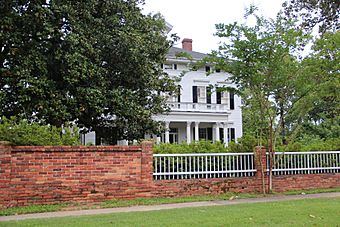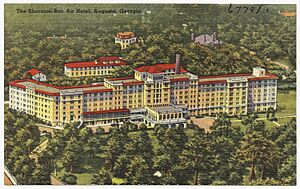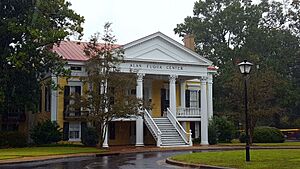Summerville (Augusta, Georgia) facts for kids
Quick facts for kids |
|
|
Summerville Historic District
|
|

A house in the Summerville
|
|
| Location | Augusta, Georgia, United States |
|---|---|
| Area | 730 acres (300 ha) |
| Built | 1780s |
| Architectural style | Greek, Spanish, Italianate, Victorian, Colonial, Queen Anne, Gothic, Federal, and Romanesque Revival |
| NRHP reference No. | 80001229 |
| Added to NRHP | May 22, 1980 |
Summerville, also known as "The Hill," is a large, fancy neighborhood in Augusta, Georgia. It is also a special historic district located northwest of downtown Augusta. This area is home to many old houses, including those where important people like John Milledge, George Walton, and Thomas Cumming once lived.
Contents
History of Summerville
Early Days: The 1700s
Summerville was first built in the 1780s. It started as its own small village, separate from the bigger city of Augusta.
Growth and Change: The 1800s
In the early 1800s, downtown Augusta had some sicknesses, like malaria. Summerville, being on higher ground, was a healthier place to live. Because of this, the U.S. Army moved its main base, the U.S. Arsenal, to Summerville. This land is now part of Augusta University.
By 1850, Summerville became a place where people lived all year round. More permanent buildings and homes were built as the town grew. In 1861, Summerville officially became its own city.
Later, Summerville turned into a popular vacation spot, especially for playing golf. It changed from a small summer getaway for local people to a winter playground. Rich business owners and politicians from the northern United States came to escape the cold winters. Two famous hotels, The Partridge Inn and the Bon Air Hotel, hosted many important guests, including former presidents. Some of these visitors even built winter homes or decided to stay in Summerville permanently.
Modern Times: The 1900s and 2000s
In 1912, the city of Augusta officially took over Summerville. This meant Summerville was no longer a separate town. Four years later, a big fire swept through downtown Augusta. This fire destroyed many businesses and homes. Because of this, many people needed new places to live, which led to a lot of new houses being built in Summerville.
Recently, in 2022, some people in Summerville and nearby areas talked about making Summerville its own city again. They believe it would help with local safety and how money is managed.
Summerville Historic District
On May 22, 1980, Summerville was added to the National Register of Historic Places. This means its important old buildings and history are protected. The historic district covers a large area, including streets like Highland Avenue, Heard Avenue, Wrightsboro Road, Milledge Road, and Cumming Road.
Famous Historic Places
Here are some of the important historic sites you can find in Summerville:
- Summerville Cemetery: An old cemetery with a lot of history.
- Appleby Library: A local library.
- Augusta Arsenal: The site of the old U.S. Army base.
- Partridge Inn: A historic hotel that first opened in 1860. Many visitors from the North stayed here to avoid cold winters. It is still open today!
- Stephen Vincent Benet House: A historic home located on the campus of Augusta University.
- College Hill: This was the home of George Walton from 1795 until he passed away in 1804.
- Bon Air Hotel: Another well-known historic hotel.
- Reid-Jones-Carpenter House: This house is also listed on the National Register of Historic Places by itself. Today, it is home to the Alan Fuqua Center for Young People.
Architecture Styles
The buildings in Summerville show many different styles of architecture. You can see examples of Greek, Italianate, Spanish, and Gothic designs, along with many others. Each style has its own unique look and features.







